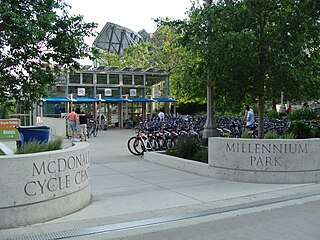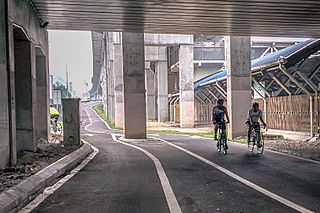
Utility cycling encompasses any cycling done simply as a means of transport rather than as a sport or leisure activity. It is the original and most common type of cycling in the world. Cycling mobility is one of the various types of private transport and a major part of individual mobility.

A bicycle-sharing system, bike share program, public bicycle scheme, or public bike share (PBS) scheme, is a shared transport service where bicycles are available for shared use by individuals at low cost.

Cycling in Melbourne is an important mode of transport, fitness, sport and recreation in many parts of the city. After a period of significant decline through the mid to late 20th century, additional infrastructure investment, changing transport preferences and increasing congestion has resulted in a resurgence in the popularity of cycling for transport. This is assisted by Melbourne's natural characteristics of relatively flat topography and generally mild climate.

Intermodal passenger transport, also called mixed-mode commuting, involves using two or more modes of transportation in a journey. Mixed-mode commuting is often used to combine the strengths of various transportation options. A major goal of modern intermodal passenger transport is to reduce dependence on the automobile as the major mode of ground transportation and increase use of public transport. To assist the traveller, various intermodal journey planners such as Rome2rio and Google Transit have been devised to help travellers plan and schedule their journey.

Bicycle commuting is the use of a bicycle to travel from home to a place of work or study — in contrast to the use of a bicycle for sport, recreation or touring.

Bicycle transportation planning and engineering are the disciplines related to transportation engineering and transportation planning concerning bicycles as a mode of transport and the concomitant study, design and implementation of cycling infrastructure. It includes the study and design of dedicated transport facilities for cyclists as well as mixed-mode environments and how both of these examples can be made to work safely. In jurisdictions such as the United States it is often practiced in conjunction with planning for pedestrians as a part of active transportation planning.

Since the advent of the bicycle in the 1860s, Chicago has been distinguished as one of the premier cycling locations in the United States, with such public cycling destinations as Grant Park, Burnham Park and the Chicago Park District's Lakefront Trail.

A bicycle parking rack, usually shortened to bike rack and also called a bicycle stand, is a device to which bicycles can be securely attached for parking purposes. It may be freestanding, or securely attached to the ground or a stationary object, such as a building. Indoor racks are commonly used for private bicycle parking, while outdoor racks are often used in commercial areas. General styles of racks include the Inverted U, Serpentine, Bollard, Grid, and Decorative. The most effective and secure bike racks are those that can secure both wheels and the frame of the bicycle, using a bicycle lock.

Cycling in New York City is associated with mixed cycling conditions that include dense urban proximities, relatively flat terrain, congested roadways with stop-and-go traffic, and streets with heavy pedestrian activity. The city's large cycling population includes utility cyclists, such as delivery and messenger services; cycling clubs for recreational cyclists; and increasingly commuters. Cycling is increasingly popular in New York City; in 2018 there were approximately 510,000 daily bike trips, compared with 170,000 daily bike trips in 2005.

McDonald's Cycle Center is a facility for a Chicago Police Department Bike Patrol Group in the northeast corner of Millennium Park in the Loop community area of Chicago, in the U.S. state of Illinois. It was formerly a bicycle station for public use. The city of Chicago built the center at the intersection of East Randolph Street and Columbus Drive, and opened it July 2004. Since June 2006, it had been sponsored by McDonald's and several other partners, including city departments and bicycle advocacy organizations. The bike station, which formerly served bicycle commuters and utility cyclists, provided lockers, showers, a snack bar with outdoor summer seating, bike repair, bike rental and 300 bicycle parking spaces as of 2004. The Cycle Center was accessible by membership and day pass. It also accommodated runners and inline skaters, but now is exclusively used by a Chicago Police Department Bike Patrol Group.

Active mobility, soft mobility, active travel, active transport or active transportation is the transport of people or goods, through non-motorized means, based around human physical activity. The best-known forms of active mobility are walking and cycling, though other modes include running, rowing, skateboarding, kick scooters and roller skates. Due to its prevalence, cycling is sometimes considered separately from the other forms of active mobility.

Bike East Bay, formerly known as East Bay Bicycle Coalition, is a Californian non-profit organization that worked since 1972 toward "promoting bicycling as an everyday means of transportation and recreation" in Alameda and Contra Costa counties of the California's East Bay.

A bicycle parking station, or bicycle garage, is a building or structure designed for use as a bicycle parking facility. Such a facility can be as simple as a lockable bike cage or shed or as complex as a purpose-built multi-level building: the common purpose is that they provide secure bicycle parking. Bicycle parking stations also go by names such as bike stations, bicycle centers and cycle centers, among many others.

Bicycle use in Portland, Oregon has been growing rapidly, having nearly tripled since 2001; for example, bicycle traffic on four of the Willamette River bridges has increased from 2,855 before 1992 to over 16,000 in 2008, partly due to improved facilities. The Portland Bureau of Transportation says 6% of commuters bike to work in Portland, the highest proportion of any major U.S. city and about 10 times the national average.

Cycling in San Francisco has grown in popularity in recent years, aided by improving cycling infrastructure and community support. San Francisco's compact urban form and mild climate enable cyclists to reach work, shopping, and recreational destinations quickly and comfortably. Though San Francisco's famed steep hills can make cycling difficult, many parts of the city are relatively flat, including some of the most densely populated. However, heavy automobile traffic, the lack of bike lanes on many streets, and difficulty in crossing major streets deter most residents from cycling frequently in San Francisco.
The San Francisco Bicycle Plan is the current guiding document for near-term bicycle transportation improvements in San Francisco, and was adopted unanimously by the Board of Supervisors on August 11, 2009. The overall goal of the plan is to "increase safe bicycle use" over an expected implementation timeline of 5 years. The plan recommends 60 near-term improvements to the bicycle route network, 52 of which are the addition of bicycle lanes to 34 miles of city streets to the already existing 45 miles of city streets with bicycle lanes.

Cycling in Canada is experienced in various ways across a geographically huge, economically and socially diverse country. Among the reasons for cycling in Canada are for practical reasons such as commuting to work or school, for sports such as road racing, BMX, mountain bike racing, freestyle BMX, as well as for pure recreation. The amount and quality of bicycle infrastructure varies widely across the country as do the laws pertaining to cyclists such as bicycle helmet laws which can differ by province.

Cycling infrastructure is all infrastructure cyclists are allowed to use. Bikeways include bike paths, bike lanes, cycle tracks, rail trails and, where permitted, sidewalks. Roads used by motorists are also cycling infrastructure, except where cyclists are barred such as many freeways/motorways. It includes amenities such as bike racks for parking, shelters, service centers and specialized traffic signs and signals. The more cycling infrastructure, the more people get about by bicycle.

Cycling in Kuala Lumpur refers to the bicycle uses in Kuala Lumpur, Malaysia for touring, recreational, work and transportation purpose. It was first appeared on 1938 when there is a first road cycling race that has been introduced in Kuala Lumpur. The introduction of the bicycle in Kuala Lumpur was later become one of the preferred transportation methods for students and mid-class citizens. As Kuala Lumpur begin its rapid urbanization progress since 1960s, the usage of bicycle start to decline as people shifting their transportation method to driving. In recent years however, the roads of the city have seen an increased presence of cyclists, whereas the importance of doing exercise has become more recognized. To match this positive change, and to reduce air pollution, the city urgently needs the introduction of more pavements and bicycle lanes, ideally by leveraging on the vast area that is currently taken up by motorways. Given that Kuala Lumpur lacks many bicycle-friendly routes suitable for cyclists in the city, however, proposals of a bicycle infrastructure of urban bicycling program were drafted, mainly under the Kuala Lumpur Structure Plan 2020 and cycling activism by Cycling Kuala Lumpur in order to encourage more citizens of Kuala Lumpur to cycle in the urban area.

Cycling is a popular mode of transport and recreational sport in the Philippines.





































